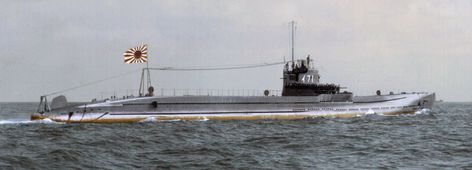SENSUIKAN!
 (Type KD6 submarine-colorized photo by Irootoko Jr)
(Type KD6 submarine-colorized photo by Irootoko Jr)
IJN Submarine I-73:
Tabular Record of
Movement
© 2001-2016 Bob Hackett & Sander Kingsepp
Revision 3
5 April 1934:
Kobe. Laid down at Kawasaki Ship Yard.[1]
20 June 1935:
Launched and numbered I-73.
7 January 1937:
Completed and attached to Kure Naval District.
Assigned to SubDiv 20. LtCdr (later Captain) Hatanaka Sumihiko (49)(former CO
of I-61) is the Commanding Officer.
10 August 1937:
LtCdr (Rear Admiral, posthumously) Kato Ryonosuke (48)
(former torpedo officer of I-123) is appointed CO.
1 December 1937:
Cdr (later Captain) Fujimoto Tsutae (48)(former CO of
I-154) is appointed CO.
20 December 1937:
Cdr (later Captain) Teraoka Masao (46)(former CO of
I-7) is appointed CO.
15 December 1938:
Cdr (Admiral, posthumously) Maejima Toshihide
(48)(former CO of RO-26) is appointed CO.
15 November 1939:
LtCdr Narizawa Chinao (52)(former CO of RO-67) is
appointed CO. [2]
15 October 1940:
LtCdr (Cdr, posthumously) Isobe Akira (52)(former CO
of RO-33) is appointed CO.
16 January 1941:
The flag of SubDiv 20 is temporarily transferred to
I-72.
11 November 1941: Operation Z:
I-73 is in Vice Admiral Shimizu
Mitsumi's (former CO of ISE) Sixth Fleet with Rear Admiral (later Vice Admiral)
Miwa Shigeyoshi's (former CO of KINU) SubRon 3 in Captain Otake Toshio's SubDiv
20 with I-71 and I-72. LtCdr Isobe Akira is the Commanding Officer. Reassigned to
the Advance Force that same day.
Admiral Shimizu convenes a meeting of all his commanders aboard his
flagship, light cruiser KATORI. LtCdr Isobe and the other commanders are
briefed on the planned attack on Pearl Harbor. Departs Saeki with ComSubDiv 20
aboard in company of I-8, I-68-72.
20 November 1941:
Arrives at Kwajalein.
23 November 1941:
Departs Kwajalein for Hawaii on her first war
patrol with ComSubDiv 20, Captain Otake embarked.
2 December 1941:
The coded signal "Niitakayama nobore (Climb Mt.
Niitaka) 1208" is received from the Combined Fleet. It signifies that
hostilities will commence on 8 December (Japan time). [2]
5 December 1941:
I-73 reconnoiters the Kealaikahiki Channel between
Maui, Kahoolawe and Lanai.
6 December 1941:
Reconnoiters Lahaina anchorage after sundown.
7 December 1941: The Attack on Pearl Harbor:
SubRon 3 is deployed
south of Oahu. Its mission is to reconnoiter and attack any ships that try to
sortie from Pearl Harbor. I-73 is positioned off the entrance to Pearl Harbor.
17 December 1941:
Departs her patrol area. Diverted to shell Johnston
Island prior to return to Kwajalein.
23 December 1941:
I-73 fires six shells at Johnston Island. One
knocks down the CAA homing tower at Sand Islet and wounds a Marine. I-73 later
reports that a telegraph pole was hit. The 5-in battery on Sand Island returns
fire with ten salvos from each gun before the submarine submerges. [4]
29 December 1941:
Arrives at Kwajalein.
12 January 1942:
Departs Kwajalein with I-71 and I-72 on her second
war patrol to relieve I-18, I-122 and I-24 that formed a picket line in the
Hawaii area. Captain Otake is again embarked aboard I-73.
15 January 1942:
LtCdr Isobe sends a situation report from his
assigned area.
27 January 1942:
240 miles W of Midway. LtCdr (later Vice Admiral)
Elton W. Grenfell's USS GUDGEON (SS-211) is returning to Pearl Harbor from her
first war patrol to the Bungo Straits off Japan. Grenfell receives an "Ultra"
message advising of the approach of three Japanese submarines (I-18, I-22 and
the I-24).
At 0900 (-12), when GUDGEON is submerged, her sound operator reports fast
propeller sounds on the port bow. Next a visual contact is made at a distance
about 5,000 yds. Grenfell identifies the target as an I-68 class submarine with
a deck gun mounted forward, making 15 knots on estimated course 255 (T). At
least six sailors are sighted on the bridge.
At 0907 LtCdr Grenfell fires three Mark 14 steam torpedoes from 1,800
yards. Due to heavy seas the visual contact is temporarily lost, but one minute
and 45 seconds later two explosions are heard. The propeller noises stop
immediately thereafter. When GUDGEON comes to perisope depth again, the target
is gone. I-73 sinks with all hands at 28-24N, 178-35E. She is the first warship
ever sunk by an American submarine.[5]
Presumed lost off Hawaii. Captain Otake is promoted Rear Admiral,
posthumously and LtCdr Isobe is promoted Cdr, posthumously.
10 March 1942:
Temporarily placed to 4th reserve at Kure. Stricken
from SubDiv 20 list.
15 March 1942:
Removed from the Navy List.
Authors' Notes:
[1] Sources suggest different dates for I-73's keel laying.
5 April 1934 appears in the authoritative "Showa Zosenshi" shipbuilding history,
while other sources suggest 5 November.
[2] Mt. Niitaka, located in Formosa (now Taiwan), is then the highest
point in the Japanese Empire.
[3] LtCdr Narizawa's name has several possible readings; in various
sources it also appears as Narusawa Sunao.
[4] I-73 is often erroneously credited with shelling Midway on 25 January
1942. In reality, the attacker was I-24.
[5] Several Japanese sources point out that I-73 was more likely lost on
28 January in a joint attack by destroyer JARVIS (DD-393), destroyer-minesweeper
LONG (DMS-12) and others S of Pearl Harbor (20-35N, 155-55W).
Thanks go to Dr. Higuchi Tatsuhiro of Japan.
– Bob Hackett and Sander Kingsepp.
Back to Submarine
Page
![]()
![]()

